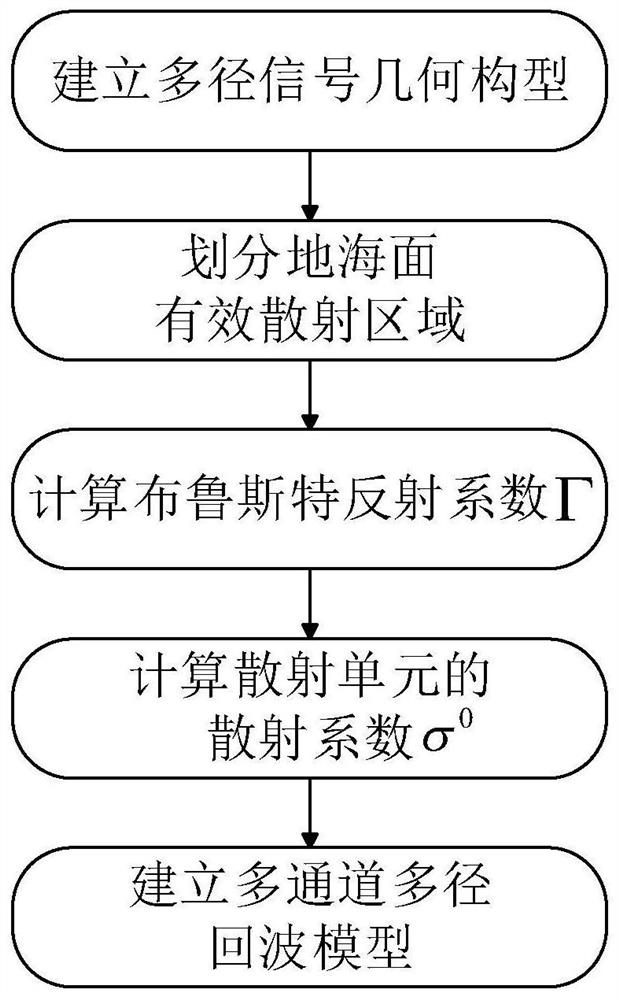Ultra-low-altitude target analysis and multipath echo modeling method for missile-borne multi-channel radar
A technology of target analysis and modeling method, which is applied in the fields of multipath echo modeling, missile-borne multi-channel radar ultra-low altitude target analysis and multipath echo modeling, which can solve the problem of large deviation of statistical characteristics and does not involve practical engineering applications. , without considering the characteristics of the scattering area of the sea surface, etc., to achieve the effect of high fidelity
- Summary
- Abstract
- Description
- Claims
- Application Information
AI Technical Summary
Problems solved by technology
Method used
Image
Examples
Embodiment 1
[0036] The existing multipath echo modeling method is simple to implement, does not analyze the large number of multipath signals that may exist in the sea surface scattering area in actual conditions, and does not consider the Brewster effect and the influence of the sea surface scattering model on different multipath echoes, so we get The traditional multipath echo modeling approximation error is large, and the statistical characteristic deviation is large, which will cause error effects on the analysis and detection of low-altitude targets in the later stage in actual processing. The present invention continues to explore in this field, and proposes a bomb-borne multi-channel radar ultra-low-altitude target analysis and multipath echo modeling method, see figure 1 , including the following steps:
[0037] (1) Establish multipath signal geometry and divide radar echo signals: For missile-borne radars to detect low-altitude targets on the sea surface, the echo signals receive...
Embodiment 2
[0048] The bomb-borne multi-channel radar ultra-low-altitude target analysis and multipath echo modeling method are the same as in embodiment 1, with reference to figure 2 The established Cartesian coordinate system, the specular reflection on the sea surface occurs in an area, that is, the grid area in the figure, S is the central scattering point, and S P It is a general scattering point, and the whole area is divided into P scattering units, where the position vector p of the central scattering point S described in step (2) S for:
[0049] p S =(x S ,y S ,z S )
[0050] where x S ,y S ,z S Respectively represent the position coordinates of the central scattering point S in the orthogonal coordinate system, z S = 0 means point S is located on the horizontal plane, through the radar position vector p R =(x R ,y R ,z R ) and the position vector p of the target T =(x T ,y T ,z T ) can get the straight line equation:
[0051]
[0052] where x R ,y R ,z R...
Embodiment 3
[0054] The bomb-borne multi-channel radar ultra-low-altitude target analysis and multipath echo modeling methods are the same as those in Embodiment 1-2, with reference to image 3 , the radar, the horizontal projection center of the target and the central scattering point S are located on the same straight line, where the scattering unit S in step (2) P , the scattering units are evenly distributed and are square. The equivalent scattering coefficient of each plot can be replaced by the scattering coefficient of its scattering center. The side length Δr of the scattering unit is equal to the distance resolution:
[0055]
[0056] Where c is the speed of light, B is the bandwidth of the transmitted signal, and the area A of each scattering unit S :
[0057] A S =Δr 2
[0058] Scattering units are divided according to distance resolution, which reduces statistical errors and achieves higher fidelity.
PUM
 Login to View More
Login to View More Abstract
Description
Claims
Application Information
 Login to View More
Login to View More - Generate Ideas
- Intellectual Property
- Life Sciences
- Materials
- Tech Scout
- Unparalleled Data Quality
- Higher Quality Content
- 60% Fewer Hallucinations
Browse by: Latest US Patents, China's latest patents, Technical Efficacy Thesaurus, Application Domain, Technology Topic, Popular Technical Reports.
© 2025 PatSnap. All rights reserved.Legal|Privacy policy|Modern Slavery Act Transparency Statement|Sitemap|About US| Contact US: help@patsnap.com



